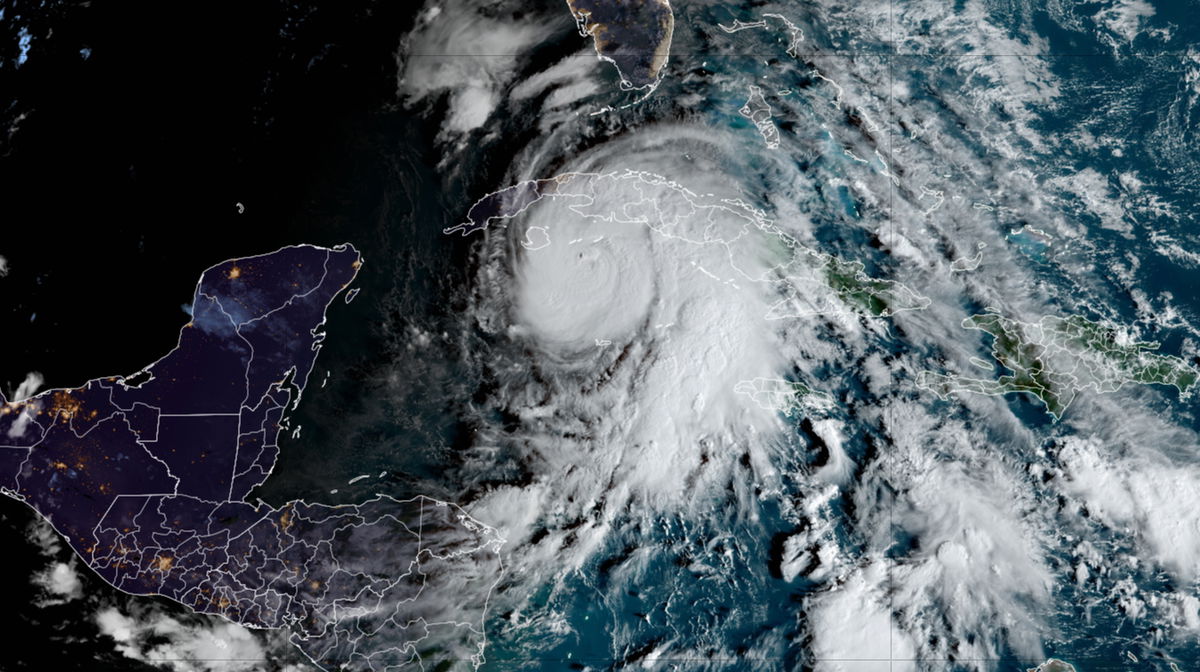Hurricane Rafael knocks out Cuba’s power grid and heads into the Gulf on a much different path

Different forecast model solutions (colored lines) for Rafael's track are overlaid on the official forecast cone (grey) from the National Hurricane Center. The storm's uncertain track has been trending west
By Mary Gilbert, CNN Meteorologist
(CNN) — Hurricane Rafael pulled away from Cuba Thursday morning after slamming into the island as a Category 3 hurricane and taking down its entire power grid for about 24 hours.
A significant shift in the storm’s forecast track means the threat to the US is dwindling, but is increasing for Mexico’s Gulf Coast.
Rafael – now a Category 2 hurricane – entered the Gulf of Mexico Wednesday night after cutting through Cuba and will track west over the southern Gulf through the weekend. The storm will be in the Gulf for days, and won’t approach landfall as a weaker storm until early next week.
Rafael’s worst wind in Cuba ended early Thursday, but rain will persist for much of the day as cleanup efforts get underway. The hurricane, which caused the island’s power grid to crash, was the fifth major hurricane of the year in the Atlantic and the strongest this late in the year since 2020.
The hurricane rapidly intensified ahead of landfall in Cuba late Wednesday afternoon. Rapid intensification is happening more frequently as the atmosphere and oceans warm due to fossil fuel pollution; Rafael is the ninth storm to rapidly intensify in the Atlantic basin this year.
Power out across Cuba
Rafael delivered a devastating blow as the first Category 3 hurricane to hit Cuba since Ian in 2022 and the second hurricane to hit the country in recent weeks.
The national electric system collapsed due to strong winds as Rafael approached the island, causing a nationwide blackout, government officials said Wednesday.
“We had several trips of the load of the system in the western zone that caused oscillations in the frequency of the system and caused it to collapse completely,” Félix Estrada Rodríguez, the director of the national dispatch of the Electric Union, told state television.
Videos of the aftermath showed power infrastructure turned into a mangled mess and power poles down on streets. Hundreds of technicians were mobilized Thursday to reestablish power connections, according to state media.
Operations at two electrical plants were partially restored and parts of eastern and central Cuba had electricity back up by Thursday afternoon, state media reported.
“Intensive work is being done in the western region to reconnect the damaged lines and fully recover the national electrical system,” Bruno Rodriguez, Cuba’s Foreign Minister, said on X.
The country’s power grid has collapsed multiple times, including when Hurricane Oscar hit in October and killed at least 7 people.
Cuban President Miguel Diaz-Canel said on X that Havana, Mayabeque and Artemisa were greatly impacted by the storm. Diaz-Canel also announced he would travel to the affected areas to personally oversee recovery operations.
Thousands of people in the western Artemisa province were evacuated from coastal zones ahead of landfall, officials said on state TV. Rafael’s core came ashore just east of Playa Majana in the province.
The Cuban civil defense placed western and central provinces under a state of alarm, urging people there to limit their movement. The normally bustling streets of Havana were largely emptied on Wednesday afternoon.
Rafael is the strongest hurricane to roam the northwestern Caribbean in November since 2009, according to data from the NOAA.
Big changes to Rafael’s path
When it first formed, Rafael looked like it could head straight for the US like five other storms before it this year. The initial forecast from the National Hurricane Center had parts of the Louisiana coast in the storm’s track forecast cone.
Now that the storm is in the Gulf, the forecast confidence has finally increased and Rafael is expected to be confined to the southern Gulf of Mexico over the next several days, rather than heading north and approaching the US Gulf Coast.
As a result, the cone has shifted dramatically to the west and aside from portions of southern Texas, the US is largely out of harms way.
Slight shifts in Rafael’s ultimate track are still possible in the coming days, but Mexico’s Gulf Coast is at the highest risk of impact. Storm-disrupting winds will take a toll on Rafael over the weekend, and it will likely return to tropical storm status by the start of next week, well before landfall.
Rafael will indirectly affect the US Gulf Coast by churning up rough seas over the Gulf over the next several days. Dangerous rip currents are also possible.
When Rafael entered the Gulf of Mexico Wednesday night, it became only the fifth hurricane to roam the Gulf of Mexico in November since 1966, according to hurricane expert Michael Lowry.
Chevron said it was transporting all personnel to shore and was shutting production at oil rigs in the Gulf of Mexico ahead of Rafael’s approach. Shell and BP moved some non-essential personnel off of several drilling platforms, according to news releases from both companies.
CNN’s Robert Shackelford, Taylor Ward, Brandon Miller, Steve Almasy, José Álvarez, Patrick Oppmann, Michael Rios, Dave Alsup, Hanna Park, Stefano Pozzebon and Abel Alvarado contributed to this report.
The-CNN-Wire
™ & © 2024 Cable News Network, Inc., a Warner Bros. Discovery Company. All rights reserved.